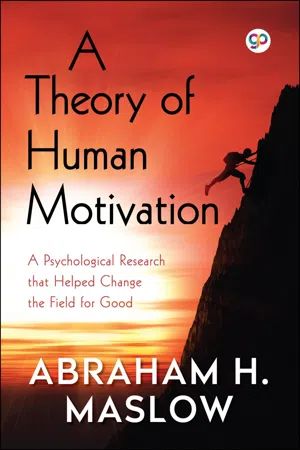
- English
- ePUB (mobile friendly)
- Available on iOS & Android
A Theory of Human Motivation
About this book
US psychologist Abraham Maslow’s A Theory of Human Motivation is a classic of psychological research that helped change the field for good. Like many field-changing thinkers, Maslow was not just a talented researcher, he was also a creative thinker – able to see things from a new perspective and show them in a different light. He studied what he called exemplary people such as Albert Einstein, Jane Addams, Eleanor Roosevelt, and Frederick Douglass rather than mentally ill or neurotic people.
Maslow generated new ideas, forging what he called 'positive' or 'humanistic psychology'. His argument was that humans are psychologically motivated by a series of hierarchical needs, starting with the most essential first. His theories parallel many other theories of human developmental psychology, some of which focus on describing the stages of growth in humans.
Frequently asked questions
- Essential is ideal for learners and professionals who enjoy exploring a wide range of subjects. Access the Essential Library with 800,000+ trusted titles and best-sellers across business, personal growth, and the humanities. Includes unlimited reading time and Standard Read Aloud voice.
- Complete: Perfect for advanced learners and researchers needing full, unrestricted access. Unlock 1.4M+ books across hundreds of subjects, including academic and specialized titles. The Complete Plan also includes advanced features like Premium Read Aloud and Research Assistant.
Please note we cannot support devices running on iOS 13 and Android 7 or earlier. Learn more about using the app.
Information

| COMPLETE NON-FICTION |
| • A Complete Biography of Alexander the Great by Jacob Abbott, ISBN: 9788180320552 • A Com... |
Table of contents
- I. Introduction
- II. The Basic Needs
- III. Further Characteristics of the Basic Needs
- IV. Summary